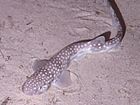Carcharhiniformes
| Ground sharks Temporal range:
| |
|---|---|

| |
| A finetooth shark, Carcharhinus isodon | |
| Scientific classification | |
| Domain: | Eukaryota |
| Kingdom: | Animalia |
| Phylum: | Chordata |
| Class: | Chondrichthyes |
| Subclass: | Elasmobranchii |
| Clade: | Neoselachii
|
| Subdivision: | Selachimorpha |
| Superorder: | Galeomorphii |
| Order: | Carcharhiniformes Compagno, 1977 |

Carcharhiniformes swellsharks, and the sandbar shark.
Members of this order are characterized by the presence of a
anal fin, and five gill
slits.
The families in the order Carcharhiniformes are expected to be revised; recent
monophyletic
.
The oldest members of the order appeared during the Middle-Late Jurassic, which have teeth and body forms that are morphologically similar to living catsharks.[1] Carchariniformes first underwent major diversification during the Late Cretaceous, initially as mostly small-sized forms, before radiating into medium and large body sizes during the Cenozoic.[2][3]
Families
According to FishBase, the nine families of ground sharks are:[4]
- Carcharhinidae (requiem sharks)
- Galeocerdonidae(Tiger shark)
- Hemigaleidae (weasel sharks)
- Leptochariidae (barbeled houndshark)
- Proscylliidae (finback catsharks)
- Pseudotriakidae (false catsharks)
- Scyliorhinidae (catsharks)
- Sphyrnidae (hammerhead sharks)
- Triakidae (houndsharks)
| Family | Image | Common name | Genera | Species | Description |
|---|---|---|---|---|---|
Carcharhinidae
|

|
Requiem sharks
|
11 | 59 | Requiem sharks are migratory, live-bearing sharks of warm seas (sometimes of brackish or fresh water) such as the viviparous, the young being born fully developed. They vary widely in size, from as small as 69 cm (2.26 ft) adult length in the Australian sharpnose shark, up to 4 m (13 ft) adult length in the oceanic whitetip shark.[5] Requiem sharks are responsible for a large proportion of attacks on humans .
|
| †Florenceodontidae?[6] | 1 | 1 | Extinct | ||
| Galeocerdonidae | 
|
Tiger shark | 1 | 1 extant | A formerly diverse genus, only one species exists today. The tiger shark is the largest member of this order |
| Hemigaleidae | Weasel sharks | 4 | 8 | Weasel sharks are found from the eastern bony fishes and invertebrates; at least two species specialize on cephalopods. They are not known to have attacked people.[8]
| |
Leptochariidae
|

|
Barbeled houndsharks | 1 | 1 | The only species of barbeled houndshark is Leptocharias smithii. It is a near threatened, as heavy fishing pressure occurs throughout its range and it is used for meat and leather .
|
| Proscylliidae | 
|
Finback catsharks | 3 | 7 | |
| Pseudotriakidae | False catsharks | 3 | 5 | False catsharks are a small family containing false catsharks and gollumsharks. It contains the only ground shark species to exhibit intrauterine oophagy, in which developing fetuses are nourished by eggs produced by their mother.[9] | |
| †Pseudoscyliorhinidae[1] | 2 | 3 | Extinct | ||
Scyliorhinidae
|

|
Catsharks | 17 | >150 | Catsharks are distinguished by their elongated, mermaid's purses. The swell sharks of the genus Cephaloscyllium fill their stomachs with water or air when threatened, increasing their girth by a factor of two to three. Some catsharks are called dogfish .
|
Sphyrnidae
|

|
Hammerhead sharks | 2 | 9 | Hammerhead sharks are named for the unusual and distinctive structure of their heads, which are flattened and laterally extended into a "hammer" shape called a continental shelves . Unlike most sharks, hammerheads usually swim in schools during the day, becoming solitary hunters at night.
|
Triakidae
|

|
Houndsharks | 9 | 40 | Houndsharks are distinguished by large spineless dorsal fins, an anal fin, and oval eyes with nictitating eyelids. They are small to medium in size, ranging from 37 to 220 cm (1.21 to 7.22 ft) in adult length. They are found throughout the world in warm and temperate waters, where they feed on fish and invertebrates on the sea bed and in midwater.[11] |
Fossil genera
The following fossil genera of Carcharhiniformes are also known:[12]
- Genus †Altusmirus Fuchs, Engelbrecht, Lukeneder & Kriwet, 2017
- Genus †Corysodon Saint-Seine, 1949
- Genus †Platyrhizodon Guinot, Underwood, Cappetta & Ward, 2013
- Genus †Vectiscyllium Duffin & Batchelor, 2024
- Family Carcharhinidae
- Genus †Abdounia Cappetta, 1980
- Genus †Archaeogaleus Guinot, Cappetta & Adnet, 2014
- Genus †Danogaleus Noubhani & Cappetta, 1997
- Genus †Eogaleus Cappetta, 1975
- Genus †Eorhincodon Li, 1997
- Genus †Fornicatus Fuchs, Engelbrecht, Lukeneder & Kriwet, 2018
- Genus †Kruckowlamna Laurito Mora, 1999
- Genus †Misrichthys Case & Cappetta, 1990
- Genus †Pseudabdounia Ebersole, Cicimurri & Stringer, 2019
- Family †Florenceodontidae Cappetta, Morrison & Adnet, 2019
- Genus †Florenceodon Cappetta, Morrison & Adnet, 2019
- Family Hemigaleidae
- Genus †Moerigaleus Underwood & Ward, 2011
- Family Galeocerdonidae
- Genus †Physogaleus Cappetta, 1980
- Family †Pseudoscyliorhinidae Stumpf, Scheer & Kriwet, 2019
- Genus †Diprosopovenator Stumpf, Scheer & Kriwet, 2019
- Genus †Pseudoscyliorhinus Müller & Diedrich, 1991
- Family Pentanchidae
- Genus †Pseudoapristurus Pollerspöck & Straube, 2017
- Family Proscyllidae
- Genus †Praeproscyllium Underwood & Ward, 2004
- Family Scyliorhinidae
- Genus †Bavariscyllium Thies, 2005
- Genus †Cadiera Guinot, Cappetta & Adnet, 2014
- Genus †Casieria Noubhani & Cappetta, 1997
- Genus †Crassescyliorhinus Underwood & Ward, 2008
- Genus †Cretascyliorhinus Underwood & Mitchell, 1999
- Genus †Foumtizia Noubhani & Cappetta, 1997
- Genus †Megascyliorhinus Cappetta & Ward, 1977
- Genus †Microscyliorhinus Case, 1994
- Genus †Orthodon Coquand, 1860
- Genus †Pachyscyllium Reinecke, Moths, Grant & Breitkreuz, 2005
- Genus †Palaeoscyllium Wagner, 1857
- Genus †Platyrhizoscyllium Adnet, 2006
- Genus †Porodermoides Noubhani & Cappetta, 1997
- Genus †Premontreia Cappetta, 1992
- Genus †Prohaploblepharus Underwood & Ward, 2008
- Genus †Protoscyliorhinus Herman, 1977
- Genus †Pteroscyllium Cappetta, 1980
- Genus †Scyliorhinotheca Kiel, Peckmann & Simon, 2013
- Genus †Sigmoscyllium Guinot, Underwood, Cappetta & Ward, 2013
- Genus †Stenoscyllium Noubhani & Cappetta, 1997
- Genus †Thiesus Guinot, Cappetta & Adnet, 2014
- Genus †Tingaleus Cappetta, 1993
- Family Triakidae
- Genus †Archaeotriakis Case, 1978
- Genus †Gomphogaleus Adnet & Cappetta, 2008
- Genus †Kallodentis Engelbrecht, Mörs, Reguero & Kriwet, 2017
- Genus †Khouribgaleus Noubhani & Cappetta, 1997
- Genus †Meridiogaleus Engelbrecht, Mörs, Reguero & Kriwet, 2017
- Genus †Pachygaleus Cappetta, 1992
- Genus †Palaeogaleus Gurr, 1962
- Genus †Palaeotriakis Guinot, Underwood, Cappetta & Ward, 2013
- Genus †Rhaibodus Böhm, 1926
- Genus †Squatigaleus Cappetta, 1989
- Genus †Xystrogaleus Adnet, 2006
Timeline of genera

References
- ^ S2CID 155785248.
- PMID 31548392.
- PMID 36535995.
- ^ Fish Identification: Ground sharks FishBase. Retrieved 28 March 2013.
- ^ Compagno, L.J.V. Family Carcharhinidae - Requiem sharks in Froese, R. and D. Pauly. Editors. 2010. FishBase. World Wide Web electronic publication, version (05/2010).
- ISSN 0891-2963.
- ^ Froese, Rainer, and Daniel Pauly, eds. (2011). "Hemigaleidae" in FishBase. February 2011 version.
- ISBN 92-5-101384-5.
- ^ Froese, Rainer, and Daniel Pauly, eds. (2012). "Pseudotriakidae" in FishBase. December 2012 version.
- ^ Froese, Rainer, and Daniel Pauly, eds. (2009). "Scyliorhinidae" in FishBase. January 2009 version.
- ^ Froese, Rainer, and Daniel Pauly, eds. (2009). "Triakidae" in FishBase. January 2009 version.
- ^ "Extinct - valid species | Species | Shark-References". shark-references.com. Retrieved 2024-03-06.
Further reading
- Froese, Rainer, and Daniel Pauly, eds. (2013) Fish Identification: Ground sharks in FishBase. March 2013 version.
- Sepkoski, Jack (2002). "A compendium of fossil marine animal genera". Bulletins of American Paleontology. 364: 560. Archived from the original on 2012-05-10. Retrieved 2011-05-17.
